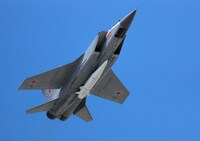“Congratulations to the Ukrainian people on a historic event!” the head of Ukraine’s air command, Mykola Oleshchuk posted, along with a lightning bolt emoji. “Yes, we brought down the ‘unparalleled’ Kinzhal!”
Reports had circulated in recent days that Ukraine had stopped a Kinzhal as part of a broader Russian air attack on Kyiv, which also included drones, in the early hours of Thursday. The drones also were stopped, officials said.
The destruction of the missile, reported to be a Kh-47 fired by a Russian MiG-31K fighter jet, demonstrated the potentially game-changing role of the Patriot system, which costs roughly $1 billion per installation.
The United States and the Netherlands each agreed to donate a Patriot system, and Ukrainian soldiers had gone to Oklahoma to be trained to use it.
Oleshchuk’s post also included a Ukrainian flag and the word “Patriot,” but he said further details would be reported “all in its own time,” so as not to assist Russia.
The Patriot, which stands for Phased Array Tracking Radar for Intercept on Target, is a surface-to-air system and one of the most advanced air-defense capabilities in the U.S. arsenal. It consists of a powerful radar, control station, power generator, launch stations and support vehicles.
It can use different types of interceptors — to destroy, for instance, aircraft and missiles in flight, and radar installations — and identifying the specific one that Ukraine used would reveal the full capabilities Kyiv now possesses. Depending on the range, this could, for instance, include the ability to shoot down planes over Belarusian or even Russian territory.
The Patriot system uses three types of missiles, all of which could “conceivably take out those Russian bombers that are hovering over Belarus air space,” said Reuben Johnson, an expert on U.S. military hardware.
But only one of the missiles — the Missile Segment Enhancement, or MSE — is designed to take out the Kinzhal. It can also intercept ballistic missiles carrying chemical or nuclear payloads at a “keep out” altitude, Johnson said, destroying an incoming missile outside the atmosphere so that the weapons don’t contaminate areas on the ground.
“That the Patriots are there and have this kind of a reach now would give any Russian pilot pause and would make him feel less than secure,” he said.
Michael Kofman, a military expert at CNA, a U.S.-based policy institute, said that too much was being made of the Kinzhal and that it was not particularly different from other ballistic missiles. The Kinzhal is a variant of Russia’s Iskander-M.
“Don’t understand the interest in Russian use of Kinzhal. There’s nothing special or particularly exciting about this system,” Kofman tweeted.
“Iskander-M is a long standing system. Hundreds have been fired. Kinzhal is an air launched variant of this system,” he wrote. “It uses the aircraft for added range and initial velocity. Otherwise it seems unremarkable. It is ‘hypersonic’ in the same way as many other ballistic missiles.”
Since October, Russia has conducted an unrelenting campaign of airstrikes against critical infrastructure in Ukraine, seeking to destroy its energy systems. The strikes have killed scores of civilians, in some cases dozens at a time when residential buildings were hit. A Kinzhal missile, for instance, is believed to have struck an apartment building in January in the central Ukrainian city of Dnipro, killing at least 46 people.
Russia’s air attacks continued overnight Friday into Saturday, with another eight attack drones shot down, Ukrainian officials said.
Previously, Ukrainian officials had said they were powerless against ballistic missile strikes. The missiles traveled so quickly that Ukraine’s air alert systems did not even have time to sound the alarm.
When the Kinzhal missile was intercepted, about 2:30 a.m. Thursday, it caused a thunderous boom that could be heard throughout the Ukrainian capital and jolted many residents out of bed.
“They were saying that the Patriot is an outdated American weapon, and Russian weapons are the best in the world,” Ukrainian air force spokesman Yurii Ihnat said on Ukrainian television. “Well, there is confirmation that it effectively works against even a super hypersonic missile.”



